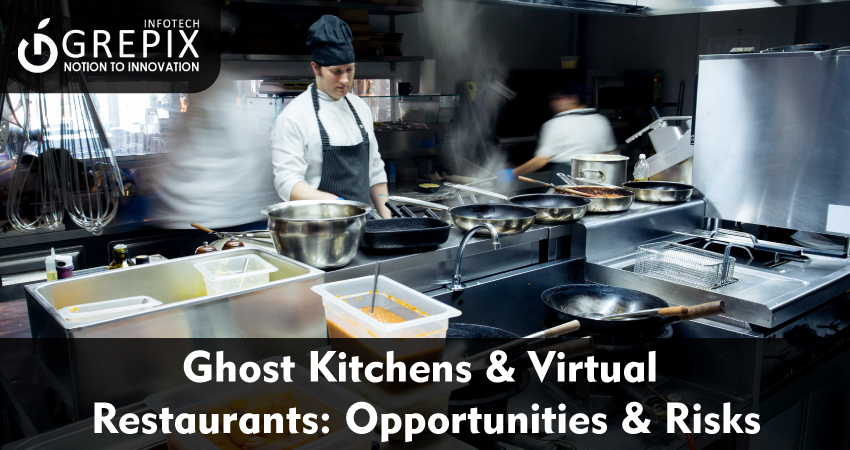Ghost Kitchens & Virtual Restaurants: Opportunities & Risks
The rapid rise of online delivery has revolutionized the food service industry, driving explosive interest in ghost kitchens, virtual restaurant business models, and the latest cloud kitchen opportunities. As the food delivery Ghost kitchen trend accelerates into 2025 and beyond, businesses are rethinking traditional restaurants adopting tech-driven, app-first strategies that maximize convenience and operational efficiency.
What exactly are ghost kitchens, and why are top brands and startups alike racing to adopt a ghost kitchens app? This article explores definitions, benefits, risks, growth stats, and essential advice for anyone considering the transition to a virtual restaurant business in this booming sector.
Ghost kitchens and virtual restaurant businesses are reshaping the future of food delivery, giving entrepreneurs agile ways to launch brands with minimal overhead. A typical ghost kitchens app or cloud kitchen operation eliminates the need for a dine-in area, focusing entirely on delivery powered by modern technology. This approach offers enormous cloud kitchen opportunities lower costs, increased flexibility, and access to booming food delivery markets. However, challenges such as stiff competition, dependence on third-party apps, and hurdles with branding and customer trust persist. Real-world case studies from companies like Kitopi, DoorDash Kitchens, and India’s Rebel Foods illustrate both major wins and common pitfalls in adopting the food delivery ghost kitchen trend. As the market is set to more than double globally by 2032, understanding the opportunities and risks involved will empower entrepreneurs and restaurant owners to make smarter, strategic moves. Dive in for actionable insights and practical guidance.
What Are Ghost Kitchens & Virtual Restaurants?
Ghost kitchens (sometimes called cloud kitchens or dark kitchens) are commercial cooking spaces designed exclusively for preparing food for delivery, with no dine-in service. They operate through food delivery apps, websites, and restaurant ordering platforms, powering both single-brand concepts and multi-brand, delivery-only restaurant portfolios.
Key Features
- No dine-in area just kitchen space and technology.
- Orders are generated and managed through a ghost kitchens app.
- Often host multiple virtual restaurant brands within a single facility.
- Rely heavily on third-party food delivery platforms (e.g., Uber Eats, DoorDash, Swiggy).
Virtual Restaurant Business Explained
A virtual restaurant exists exclusively online. Unlike a typical restaurant, everything menu presentation, branding, marketing is orchestrated digitally. Many virtual brands leverage shared ghost kitchens to launch rapidly, test concepts, and reach broad audiences at low cost.
How the Model Works
- Brands create digital-only menus and register on major delivery apps.
- Orders are routed through these apps or custom ghost kitchens app solutions.
- Kitchen staff prepare and package food for speedy hand-off to local delivery drivers.
- Consumers receive food quickly, leaving feedback that feeds data into the system.
Benefits of Ghost Kitchens for Startups
Launching a virtual restaurant business via a ghost kitchens app offers significant cloud kitchen opportunities, especially for startups and expanding food entrepreneurs.
Lower Costs & Fast Setup
- Dramatically reduced startup expenses (no waitstaff, minimal décor, cheaper real estate).
- Faster go-to-market; most ghost kitchens can be operational within weeks.
- Ideal for testing new restaurant concepts with minimal risk.
Flexibility & Scalability
- Test, pivot, or expand new menus and brands rapidly.
- Failure is less costly; successful menus can be scaled system-wide.
- Centralized control over multiple virtual brands.
Data-Driven Growth
- Cloud kitchen apps gather real-time ordering data.
- Menu optimization using customer behavior, upsell patterns, and dynamic pricing.
- Technology allows prompt adaptation to food delivery ghost kitchen trend shifts.
Market Reach & Convenience
- Meet demand for food delivery in urban centers and underserved areas.
- Restaurant” options expand with each app update quickly catering to local favorites or global cuisines.
- White-label, branded delivery elevates customer experience and loyalty.
Real-Life Case Studies
- DoorDash Kitchens (US): Multipurpose ghost kitchen facilities power various brands with robust delivery coverage, increasing fulfillment rates while lowering costs.
- Karma Kitchen & Taster (UK): Tech-driven models that allow rapid launch and central management of multiple virtual restaurant business ventures.
- Kitopi (UAE): Operates more than 100 cloud kitchens with advanced apps, AI-driven kitchens, and multinational menu offerings.
Risks & Challenges of Ghost Kitchens
Even as digital-first food delivery ghost kitchen trends open new doors, startups must be wary of significant operational and business risks.
Intense Competition & Market Saturation
- Lower barriers mean more competitors; the market is crowded and price-sensitive.
- Differentiation is tough as consumers are bombarded with choices on apps.
Brand Visibility & Customer Loyalty
- No storefront means no walk-in traffic; brands rely on digital discovery and paid ads.
- Building customer trust and recognition is harder without face-to-face interactions.
- Online reviews and order ratings can make or break new brands instantly.
Third-Party Dependency
- Apps charge steep commissions (15-30%), squeezing margins.
- Control over the end-customer experience is limited; delivery issues are common.
Operational Complexity
- Receiving, preparing, and dispatching high volumes of orders with accuracy requires advanced order management systems.
- Food quality must be maintained through transit; poor packaging or mishandling can impact ratings and repeat orders.
- Regulatory compliance, health inspections, and local zoning still apply and rules change frequently.
Food Safety Risks
Stringent food safety and hygiene practices are essential; lapses can quickly damage reputation, especially since customers cannot see behind the scenes.
Cloud Kitchen Opportunities: Market Outlook 2025
The future looks bright for the cloud kitchen and food delivery ghost kitchen trend. Here’s what to expect by 2025 and beyond:
Explosive Market Growth
- The global ghost kitchen market is projected to grow from $88.4 billion in 2025 to $196.7 billion by 2032 a CAGR of 12.1%.
- In India, the sector will jump from $740 million (2025) to $2.07 billion (2032), driven by urban demand, digital payments, and mobile adoption.
- The US market is expected to reach $27.47 billion by 2032.
- Asia Pacific (China, India, Japan, Korea) accounts for about 28.6% of the global share due to urban lifestyles and food app proliferation.
Notable Trends
- Dominance of independent cloud kitchens, but rapid expansion of shared kitchen and kitchen pod models.
- Increasing adoption of white-label, branded ghost kitchens app tech infrastructure.
- Growth in diversified menu offerings and hyper-targeted marketing via delivery platforms.
| Region | Market Size 2025 | Market Size 2032 | CAGR |
|---|---|---|---|
| Global | $88.4bn | $196.7bn | 12.1% |
| India | $740m | $2.07bn | 15.8% |
| US | – | $27.47bn | – |
| Asia Pacific | 28.6% of global | – | – |
Conclusion
Ghost kitchens and the virtual restaurant business promise unmatched agility in today’s delivery-first food economy. Leveraging the right ghost kitchens app, entrepreneurs can explore cloud kitchen opportunities, cut costs, experiment with innovative menus, and scale brands nationally or globally. Yet, the food delivery ghost kitchen trend also brings major risks intensifying competition, high commission fees, lack of direct customer interaction, operational challenges, and the critical need for digital branding and food safety.
As this sector is set to double in size by 2032, aspiring and established restaurateurs must weigh the opportunities and threats carefully. Embrace the technology, invest in digital customer engagement, and always prioritize food quality and service standards. Ready to launch your virtual restaurant business or expand via the latest ghost kitchens app technology? Now is the time to act capitalize on one of the fastest-growing trends in foodservice. Share this article to spread insights and help others join the food delivery revolution
FAQs
1. What is the difference between a ghost kitchen and a virtual restaurant?
A ghost kitchen is a physical location where food is prepared solely for delivery, while a virtual restaurant exists only online, often operating out of a ghost kitchen to reach customers through apps.
2. How do ghost kitchen apps maximize efficiency?
Ghost kitchen apps centralize orders, streamline workflows, optimize menus using data, and manage multi-brand setups from a single dashboard, making scaling and oversight easier.
3. What are the best cloud kitchen opportunities for 2025?
Top opportunities include niche cuisines, hyper-localized menus, partnerships with major delivery platforms, and leveraging AI-driven menu optimization for profitability.
4. What are the main risks in starting a food delivery ghost kitchen?
Risks include market saturation, high dependence on third-party apps, complex operations, limited customer loyalty, and the challenge of upholding quality and food safety in a delivery-only model.
5. Is the food delivery ghost kitchen trend here to stay?
Yes. The food delivery ghost kitchen trend is expected to see double-digit annual growth through 2032 globally as consumer demand for convenience continues to rise.







